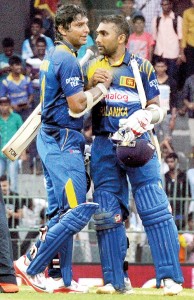The way the script went radically wrong
View(s):I strongly believe that the script in the last episode of the Sanga-Mahela saga was flawed. The ending was a huge anti-climax and ill fitting. It was as if suddenly in the middle of an idolised drama, the stage has collapsed beneath the actors’ feet and they play no more.
It should not have been the final outing of those two great cricketing ambassadors – I mean how the script was written. An entire nation was watching the drama at the Sydney Cricket Ground during the first quarter-final of the 2015 Cricket World Cup.

It was not the fairytale ending Kumar Sangakkara and Mahela Jayawardane expected, but both have served their country with great loyalty. - File pic
The same wicket — with bowlers as fast as the South African pacies operating — produced a match that nearly scored seven hundred runs when Australia took on the Sri Lankans, a week before. But, on Wednesday the surface had taken a sudden reversal.
The next morning ‘The Sydney Morning Herald’ had penned it down quite to the point. The article covering the Lankan match had explained the wicket in this manner: “For much of the afternoon, circumstances forced Sangakkara to play an old-school one-day innings. A sporting wicket made to order for South Africa’s fast bowlers revived memories of the SCG in its pacy 70s. Bounce accounted for both of Sri Lanka’s openers. One delivery from Morne Morkel to Sangakkara steepled so suddenly that it flew over wicketkeeper Quinton de Kock’s vertical leap for four byes. Kyle Abbott and Dale Steyn found enough seam and bounce to trouble any batsmen, let alone the Sri Lankans who must have been wondering what had transformed last week’s sleepy surface into this rager.
“Sangakkara adapted. From his first 23 balls, he took two singles to fine leg and no risks running between wickets; no chance was his international career going to end on the SCG like Mike Hussey’s. From his first 42 balls, Sangakkara — who is yet to draw the curtain on his Test career — scored six runs. Any other batsman in the world, and the crowd would have been screaming at him. Instead, there was an “Artist at Work” kind of hum, an appreciation for the difficulty of the task. His authority alone was recalibrating notions of a par score, from 300 down to 200 and perhaps even less, as rapidly as a storm front blowing from the North Sea onto the Old Course. When great players struggle, the game becomes harder for all players. But this would turn out to be wishful thinking when Sri Lanka’s bowlers proved as incapable of exploiting the conditions as their batsmen.”
Yes, notwithstanding the limitations of the Lankan composition, Sangakkara was adamant that he was going to make his final call of the World Cup his own. He scored more centuries than any other during the tournament. He singlehandedly made the Lankans an opposition worthy of its reputation.
When it comes to percentages Sangakkara is the best and there is no other among the rest. He admits that his friend Mahela is always a better batsman than he is. Yet, the difference between the two inseparable friends is the approach. Sangakkara calculates every move. Not only his, but the opposition’s too. Almost in robotic reciprocation, Sanga reacts to the opposition. He not only reciprocates, but, converts his reciprocation into elegant cricket strokes that keep a crowd of 40 thousand plus wowed. Sangakkara’s cricket is as fluent as his English, but those who know him well are aware how much hard work that has been put into that effort and what a lot of dedication, blood, sweat and years have been put into it. He is an actor on turf and wants his role to be that of a hero who runs away with the girl at the end of the show.
Mahela is essentially a rhythm player. He has a born gift for stroke making and plays it with touch and deft class, but what he possesses has come naturally. Unlike Kumar Sangakkara, those who saw Mahela as a teenager knew that his place among the Sri Lankan top order batting was almost assured and it was only a matter of time.
He cannot and does not play the main anchor role that Kumar Sangakkara can play in the Lankan batting order. The day that he is in touch, Mahela is incomparable. He has every shot in the book and he creates more when he is on song.
When Mahela walked onto the crease when the Lankans were reeling at three for almost nothing against little known Afghanistan, he batted as if he has been there all his life. He carried on till the team was in safer waters. Had the Lankans moved on that reverse mode in the game against the Afghans, they could have bid adieu to the tournament in the first round itself.
Besides his batting, Mahela reads the game much more than the others in the playing Xl. There is an anecdote about Mahela. Arjuna Ranatunga once recalled how Mahela, who had just won the national crest, had just walked up to him and made a certain suggestion. Arjuna said it was exactly what he as captain was contemplating.We at this end saw the Lankans were living in a bubble all this while. This was so even when they won the ICC T-20 tournament or the Asia Cup or beat England on their own soil. Every time it was the batting that kept them afloat. Sometimes even the bowlers did their job with the bat more than expected. Remember Herath’s little cameo with his captain Mathews? It turned the Test match against England on its head and the Lankan finally ended up winning the series.
The real bubble in Lankan cricket was and is — its bowling. Even when the triumphant Lankans returned to the island from England, we screamed that ‘there are chinks in our armour’. It was Herath and no one else – not even Malinga who won a match for Sri Lanka more or less.
No two tours contained the same bowling combination. The opposing batsmen were taking centuries off our bowling even when they ended up at the losing end.
However, the giant woke up towards the end of the New Zealand series. It was a good chance for those who really wanted to exploit the situation.
Suddenly fast bowling coach Chaminda Vaas was made the scapegoat. The situation helped us – the scribes. It gave the opportunity to get a series of readworthy headlines. But, for Sri Lanka cricket the sidelining of Vaas or the refusal of Champaka Ramanayake to join the ranks or the hiring of Rumesh Ratnayake or his extension with the Lankan squad till the end of their act at the World Cup did not make any difference. When the moves were made the Lankan bowlers were operating badly. Then at the end of the tournament what effect had Ratnayake made? Lasith Malinga was mediocre and the rest of the fast bowlers were bad.
Yet, there was something that was very visible. The team management walking past each other with looks of ‘wish I could kill you’. That did not help the Lankan cause in any manner, but, it looked as if the cricketers held it together on their own, till one doctored wicket, weak-kneed batting and far below par bowling helped us burst the bubble and the script went wrong.


